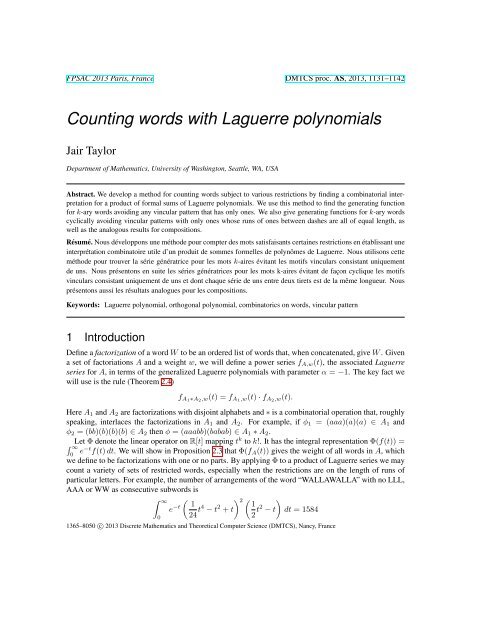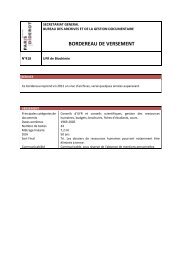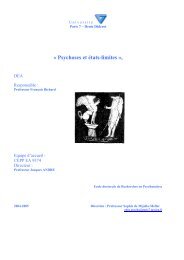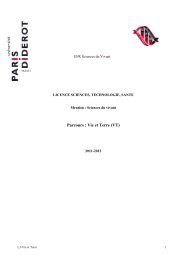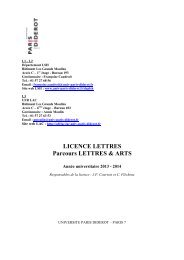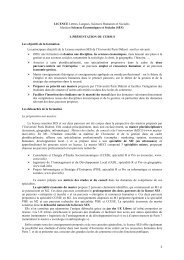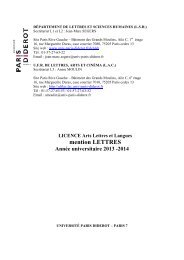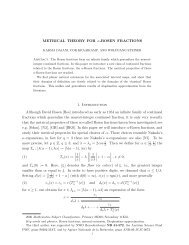Counting words with Laguerre polynomials - liafa
Counting words with Laguerre polynomials - liafa
Counting words with Laguerre polynomials - liafa
You also want an ePaper? Increase the reach of your titles
YUMPU automatically turns print PDFs into web optimized ePapers that Google loves.
FPSAC 2013 Paris, France DMTCS proc. AS, 2013, 1131–1142<br />
<strong>Counting</strong> <strong>words</strong> <strong>with</strong> <strong>Laguerre</strong> <strong>polynomials</strong><br />
Jair Taylor<br />
Department of Mathematics, University of Washington, Seattle, WA, USA<br />
Abstract. We develop a method for counting <strong>words</strong> subject to various restrictions by finding a combinatorial interpretation<br />
for a product of formal sums of <strong>Laguerre</strong> <strong>polynomials</strong>. We use this method to find the generating function<br />
for k-ary <strong>words</strong> avoiding any vincular pattern that has only ones. We also give generating functions for k-ary <strong>words</strong><br />
cyclically avoiding vincular patterns <strong>with</strong> only ones whose runs of ones between dashes are all of equal length, as<br />
well as the analogous results for compositions.<br />
Résumé. Nous développons une méthode pour compter des mots satisfaisants certaines restrictions en établissant une<br />
interprétation combinatoire utile d’un produit de sommes formelles de polynômes de <strong>Laguerre</strong>. Nous utilisons cette<br />
méthode pour trouver la série génératrice pour les mots k-aires évitant les motifs vinculars consistant uniquement<br />
de uns. Nous présentons en suite les séries génératrices pour les mots k-aires évitant de façon cyclique les motifs<br />
vinculars consistant uniquement de uns et dont chaque série de uns entre deux tirets est de la même longueur. Nous<br />
présentons aussi les résultats analogues pour les compositions.<br />
Key<strong>words</strong>: <strong>Laguerre</strong> polynomial, orthogonal polynomial, combinatorics on <strong>words</strong>, vincular pattern<br />
1 Introduction<br />
Define a factorization of a word W to be an ordered list of <strong>words</strong> that, when concatenated, give W . Given<br />
a set of factoriations A and a weight w, we will define a power series f A,w (t), the associated <strong>Laguerre</strong><br />
series for A, in terms of the generalized <strong>Laguerre</strong> <strong>polynomials</strong> <strong>with</strong> parameter α = −1. The key fact we<br />
will use is the rule (Theorem 2.4)<br />
f A1∗A 2,w(t) = f A1,w(t) · f A2,w(t).<br />
Here A 1 and A 2 are factorizations <strong>with</strong> disjoint alphabets and ∗ is a combinatorial operation that, roughly<br />
speaking, interlaces the factorizations in A 1 and A 2 . For example, if φ 1 = (aaa)(a)(a) ∈ A 1 and<br />
φ 2 = (bb)(b)(b)(b) ∈ A 2 then φ = (aaabb)(babab) ∈ A 1 ∗ A 2 .<br />
∫ Let Φ denote the linear operator on R[t] mapping t k to k!. It has the integral representation Φ(f(t)) =<br />
∞<br />
e −t f(t) dt. We will show in Proposition 2.3 that Φ(f<br />
0<br />
A (t)) gives the weight of all <strong>words</strong> in A, which<br />
we define to be factorizations <strong>with</strong> one or no parts. By applying Φ to a product of <strong>Laguerre</strong> series we may<br />
count a variety of sets of restricted <strong>words</strong>, especially when the restrictions are on the length of runs of<br />
particular letters. For example, the number of arrangements of the word “WALLAWALLA” <strong>with</strong> no LLL,<br />
AAA or WW as consecutive sub<strong>words</strong> is<br />
∫ ∞<br />
( 2 ( )<br />
1 1<br />
e −t 24 t4 − t 2 + t)<br />
2 t2 − t dt = 1584<br />
0<br />
1365–8050 c○ 2013 Discrete Mathematics and Theoretical Computer Science (DMTCS), Nancy, France
1132 J. Taylor<br />
as we will see.<br />
In Section 3, we describe the transformation T that turns certain ordinary generating functions into<br />
<strong>Laguerre</strong> series. The transformation can be described in terms of the Laplace transform, and so can be<br />
easily implemented in mathematical software packages. We can use T to determine the <strong>Laguerre</strong> series<br />
for a variety of sets of factorizations A, and use them to derive formulas and generating functions to count<br />
<strong>words</strong> that obey various restrictions.<br />
In particular, we use this technique to analyze certain pattern avoidance problems. A vincular, or<br />
generalized, pattern is a pattern <strong>with</strong> dashes such as 13-2. This is a generalization of classical permutation<br />
patterns where the dashes are used to indicate that the numbers on either side are not required to be<br />
adjacent, but all others are. We will only study patterns that have only ones, such as 111 − 1 − 11, so we<br />
define pattern avoidance only in this context. A word W = s 1 · · · s l , <strong>with</strong> each s i in some alphabet S,<br />
contains a vincular pattern τ = 1 k1 - · · · -1 kn if there is a subsequence of W consisting of m = k 1 +. . .+k n<br />
identical letters of which the first k 1 are consecutive, the next k 2 are consecutive, and so on. Formally,<br />
we require that there are indices 1 ≤ i 1 < i 2 < . . . < i m ≤ l <strong>with</strong> s i1 = . . . = s im and i j+1 − i j = 1<br />
for j ≠ k 1 , k 1 + k 2 , . . . , k 1 + . . . + k n−1 . Otherwise, we say that W avoids τ. These patterns were first<br />
studied by Babson and Steingrímsson (Babson and Steingrímsson, 2000), who showed that many statistics<br />
of interest can be classified in terms of vincular patterns. The term vincular itself was coined by Claesson<br />
in (Bousquet-Mélou et al., 2010), from the Latin vinculare, to bind. Words avoiding vincular patterns are<br />
studied in (Bernini, Ferrari, and Pinzani, 2009; Burstein, 1998; Burstein and Mansour, 2003a; Heubach<br />
and Mansour, 2009; Burstein and Mansour, 2003b; Mansour, 2006). In this paper we will study vincular<br />
patterns <strong>with</strong> all ones, such as τ = 111-11. A word avoids this pattern if it does not have five appearances<br />
of the same letter in the word, of which the first three and the last two are consecutive. Although such<br />
patterns are useless in the context of permutations, where only the pattern 1 can be contained, they are<br />
meaningful in the context of general <strong>words</strong> on the alphabet N where letters may be repeated.<br />
In Section 4, we give a formula to calculate the generating function for the number of <strong>words</strong> avoiding<br />
any such vincular pattern <strong>with</strong> only ones. This formula involves the use of the maps T and Φ, but these can<br />
be easily calculated. For example, we can use Sage to compute the the generating function ∑ W xlen(W )<br />
where the sum is taken over all ternary <strong>words</strong> W avoiding the pattern 11-11, where len(W ) is the length<br />
of W , the number of letters counting multiplicity:<br />
6 x 7 − 6 x 6 + 6 x 5 − 2 x 4 − 5 x 3 + 9 x 2 − 5 x + 1<br />
16 x 4 − 32 x 3 + 24 x 2 − 8 x + 1<br />
= 1 + 3x + 9x 2 + 27x 3 + 78x 4 + 222x 5 + . . . .<br />
Finally, we give a cyclic version of this result for the case of patterns 1 m -1 m - · · · -1 m , where all runs of<br />
ones are the same length. This gives the generating functions for <strong>words</strong> so that any cyclic permutation of<br />
their letters avoids such a pattern. This generalizes a result of Burstein and Wilf (Burstein and Wilf, 1997)<br />
who give the generating function for the number of <strong>words</strong> cyclically avoiding 1 m .<br />
Acknowledgments<br />
The author would like to thank Sara Billey, Ira Gessel, Silvia Heubach, Yannick van Huele, Toufik Mansour,<br />
Brendan Pawloski, Austin Roberts, Byron Schmuland, William Stein and the reviewers for their<br />
extraordinarily helpful support. Without them this paper would still be “floating in platonic heaven”.
<strong>Counting</strong> <strong>words</strong> <strong>with</strong> <strong>Laguerre</strong> <strong>polynomials</strong> 1133<br />
2 <strong>Laguerre</strong> series<br />
Define the <strong>polynomials</strong> l k (t) by their generating function<br />
∞∑<br />
k=0<br />
l k (t)x k = e tx<br />
1+x .<br />
These <strong>polynomials</strong> are a form of <strong>Laguerre</strong> polynomial. Specifically, l k (t) = (−1) k L (−1)<br />
k<br />
(t) where<br />
k∑<br />
( ) k + α t<br />
k (t) = (−1) i i<br />
k − i i!<br />
L (α)<br />
i=0<br />
defines the generalized <strong>Laguerre</strong> <strong>polynomials</strong>. They have been found to have a number of interesting<br />
combinatorial properties, beginning <strong>with</strong> their use by Even and Gillis to count generalized derangements<br />
when α is set to 0 in (Even and Gillis, 1976). This was later extended by Foata and Zeilberger who use<br />
α to keep track of the number of cycles (Foata and Zeilberger:i, 1988). For our purpose, we may assume<br />
α = −1.<br />
Define a word W on an alphabet S to be an ordered list s 1 · · · s n of letters s i ∈ S. A subword of W<br />
is a word s k s k+1 · · · s k+m . Note that we require the indices in a subword to be consecutive, while some<br />
authors do not. A word using letters from the alphabet [k] = {1, 2, . . . , k} is called k-ary, and a word in<br />
which no two adjacent letters are the same is called a Carlitz word, after Leonard Carlitz.<br />
Our work is based on the following remarkable result of Ira Gessel (Gessel, 1989, Section 6), which he<br />
found in the context of a generalization of rook theory. We present an unlabeled version.<br />
Theorem 2.1. Let Φ be the linear functional on <strong>polynomials</strong> in t given by Φ(t n ) = n!. Given nonnegative<br />
integers k 1 , . . . , k m , the number of Carlitz <strong>words</strong> on an alphabet of m symbols <strong>with</strong> the ith symbol used<br />
k i times is<br />
( ∏<br />
Φ<br />
i<br />
)<br />
l ki (t) .<br />
For example, in (Blom et al., 1998) the authors consider the “Mississippi Problem”. How many arrangements<br />
of the letters in the word “MISSISSIPPI” have no adjacent letters the same We can use the<br />
preceding theorem to calculate this directly. There is one M, four I’s, four S’s, and two P ’s. So the<br />
solution is<br />
∫ ∞ ( ) (<br />
Φ(l 1 (t)l 4 (t)l 4 (t)l 2 (t)) = e −t 1<br />
t<br />
24 t4 − 1 2 t3 + 3 ) 2 ( 1<br />
2 t2 − t<br />
2 t2 − t)<br />
dt = 2016.<br />
Using Theorem 2.1, it is easy to see combinatorially that<br />
0<br />
⎧<br />
⎨ 2 if i = j<br />
Φ(l i (t)l j (t)) = 1 if |i − j| = 1<br />
⎩<br />
0 if |i − j| > 1<br />
(1)<br />
and so the <strong>polynomials</strong> l k (t) are “almost” orthogonal <strong>with</strong> respect to Φ.
1134 J. Taylor<br />
Note that l k (t) is a polynomial of degree k; so the matrix of l k ’s expanded into powers of t is triangular<br />
<strong>with</strong> no zeroes on the diagonal, and so {l k } k forms a basis of R[t]. It is natural to ask, then, what is<br />
the expansion of l i (t)l j (t) in this basis These are known as linearization coefficients. The linearization<br />
coefficients of general <strong>Laguerre</strong> <strong>polynomials</strong>, <strong>with</strong> α indeterminate, is known (Foata and Zeilberger:i,<br />
1988; Zeng, 1992), but we will need a combinatorial interpretation of the case α = −1. To give it, we<br />
need a few more definitions.<br />
Definition. A factorization φ is a finite, ordered list of nonempty <strong>words</strong> (φ 1 ) · · · (φ n ), and φ 1 , . . . , φ n are<br />
the parts or factors of φ. If the concatenation of these <strong>words</strong> is a word W , we say that φ is a factorization<br />
of W . We take the convention that the empty word has exactly one factorization, namely the empty<br />
factorization which has no factors. Abusing notation, we identify a word W <strong>with</strong> the factorization (W )<br />
in one part, and the empty word <strong>with</strong> the empty factorization, writing ∅ for both. We write par(φ) = n,<br />
the number of factors, and len(φ) for the length of φ, that is, the length of the word W when φ is a<br />
factorization of W .<br />
For example, φ = (MISS)(IS)(IP P I) is a factorization of “MISSISSIPPI”, <strong>with</strong> par(φ) = 3 and<br />
len(φ) = 11. Frequently, we will be interested in the factorization itself <strong>with</strong>out thinking of it as a<br />
factorization of a particular word. Rather, the spaces between the factors should be thought of as slots to<br />
be filled <strong>with</strong> nonempty <strong>words</strong>.<br />
Denote by n i,j,k the number of factorizations over the alphabet {a, b} <strong>with</strong> k parts and exactly i a’s<br />
and j b’s so that each part is Carlitz. For example, n 2,5,3 = 6: the possibilities are (bab)(bab)(b),<br />
(babab)(b)(b) and the different permutations of these sets of factors.<br />
Lemma 2.2. We have, for all i, j ∈ N,<br />
l i (t)l j (t) = ∑ k<br />
n i,j,k l k (t).<br />
Proof. Note that if p(t) = a 0 + a 1 t + . . . + a n t n is a polynomial and Φ(t m p(t)) = 0 for all m, then<br />
a 0 m! + a 1 (m + 1)! + . . . + a n (n + m)! = 0.<br />
This is a homogenous linear recurrence relation <strong>with</strong> constant coefficients for the factorial sequence,<br />
which is impossible unless a 0 = a 1 = . . . = a n = 0 since it grows superexponentially. Since {l k (t)} k<br />
forms a basis for R[t], if Φ(p(t)l k (t)) = 0 for all k then we can still conclude p(t) = 0. So it is enough to<br />
show that<br />
( )<br />
∑<br />
Φ (l i (t)l j (t)l m (t)) = φ n i,j,k l k (t)l m (t) .<br />
k<br />
We know that the left hand side counts the number of Carlitz arrangements of i a’s, j b’s, and m c’s,<br />
while the right hand side gives the total number of pairs (φ, W ) where φ is a factorization in k parts <strong>with</strong><br />
i a’s and j b’s <strong>with</strong> each part Carlitz, and W is a Carlitz word <strong>with</strong> k x’s and m c’s. There is a simple<br />
bijection between these sets. Given such a pair (φ, W ), we can get a Carlitz arrangement of i a’s, j b’s and<br />
m c’s by replacing the ith x of W <strong>with</strong> the ith part of φ. For example, if φ = (ab)(bab) and W = cxcx,<br />
we get the Carlitz word cabcbab. This process is reversible: given a Carlitz word on a, b, c we replace the<br />
c’s by parentheses to make a factorization φ <strong>with</strong> only the letters a and b, and to get W we replace each
<strong>Counting</strong> <strong>words</strong> <strong>with</strong> <strong>Laguerre</strong> <strong>polynomials</strong> 1135<br />
maximal subword that does not contain c by a single x, getting a word <strong>with</strong> only c’s and x’s. For example,<br />
given the word abcbcab, we get the pair W = xcxcx, and φ = (ab)(b)(ab). The maximality condition<br />
guarantees that W will be Carlitz.<br />
Let S be an alphabet, not necessarily finite, and let A be any set of factorizations of <strong>words</strong> on S. We<br />
say that a word W is an allowed word of A if the factorization of W in one part (or zero for the empty<br />
word) is in A. We think of A as some set of factorizations on S we are interested in investigating. For<br />
example, in the above proof we might have defined A to be those factorizations of <strong>words</strong> on S = {a, b}<br />
so that each part is Carlitz.<br />
Definition. Let φ be a factorization of a word W on an alphabet S. For T ⊆ S and a word W on S, let<br />
φ| T be the factorization created from φ whose parts are the maximal sub<strong>words</strong> in each part of φ that have<br />
only letters in T listed in the same order they appeared in φ. The resulting factorization will have only<br />
letters from T , <strong>with</strong> parts of φ possibly split up into multiple parts of φ| T . We call φ| T the restriction of<br />
the factorization to T . For example, if S = {a, b} and T = {a}, then the restriction of the factorization<br />
(aabba)(aab)(b)(aaab) to T is φ| T = (aa)(a)(aa)(aaa). If φ contains no letters from T , we define φ| T<br />
to be the empty factorization.<br />
Definition. Let A 1 and A 2 be two sets of factorizations so that the alphabets of symbols S 1 , S 2 used in<br />
A 1 and A 2 , respectively, are disjoint. Let S = S 1 ∪ S 2 , and denote by A 1 ∗ A 2 the set of factorizations φ<br />
of <strong>words</strong> on S so that φ| S1 ∈ A 1 and φ| S2 ∈ A 2 .<br />
Thus the factorizations in A 1 ∗ A 2 are obtained by interlacing the parts of factorizations in A 1 and<br />
A 2 . The factors of φ 1 and φ 2 must appear in the correct order in φ, but a factor of φ may be a word<br />
that is concatenated from factors that alternate between φ 1 and φ 2 . For example, if (a)(aa)(a) ∈ A 1 and<br />
(b)(bb) ∈ A 2 then φ = (abaa)(abb) ∈ A 1 ∗A 2 since its restrictions to {a} and {b} are φ| {a} = (a)(aa)(a)<br />
and φ| {b} = (b)(bb).<br />
It is easy to see that ∗ is associative and commutative. Note also that A 1 , A 2 ⊆ A 1 ∗ A 2 if A 1 and<br />
A 2 contain the empty factorization. If φ ∈ A 1 , for example, then φ| S1 = φ ∈ A 1 and φ| S2 = ∅ ∈ A 2<br />
when S 1 , S 2 are the disjoint alphabets of A 1 , A 2 . The allowed <strong>words</strong> in A 1 ∗ A 2 are often of interest; for<br />
example, if we have singleton alphabets S i = {i} for i = 1, . . . , n, and A i consists of those factorizations<br />
<strong>with</strong> all parts having length one, then the factorizations in A 1 ∗ · · · ∗ A n are those so that each factor is<br />
Carlitz, and the <strong>words</strong> of A 1 ∗ · · · ∗ A n are exactly the Carlitz <strong>words</strong>.<br />
Definition. Given a set of factorizations A on an alphabet S, a weight is a function w from A and all of<br />
the restrictions of factorizations in A into a polynomial ring R[x 1 , x 2 , . . .] that commutes <strong>with</strong> restriction<br />
in the sense that if φ ∈ A and T ⊆ S, then w(φ) = w(φ| T ) w(φ| S\T ).<br />
Note that in particular, if A = A 1 ∗ A 2 for some sets of factorizations A 1 , A 2 then w is also a weight on<br />
A 1 and A 2 . Also note that taking T to be empty forces w(∅) = 1. Typically we will take the weight w(φ)<br />
to be a monomial x n1(φ)<br />
1 x n2(φ)<br />
2 · · · xm<br />
nm(φ) where each n i (φ) is a statistic so that x ni(φ)<br />
i is multiplicative<br />
in the above sense. Examples include the length of φ, len(φ); the number of distinct symbols in φ; the<br />
number of appearances of a particular symbol; the sum of φ, sum(φ), if the symbols in φ are nonnegative<br />
integers; or simply w = 1 if we wish to enumerate a finite set. We will write par(φ) for the number of<br />
parts of φ; but x par(φ) is not a weight.
1136 J. Taylor<br />
Definition. Let A be a set of factorizations on an alphabet S and w be a weight on A. Define the <strong>Laguerre</strong><br />
series of A <strong>with</strong> respect to w to be the formal power series<br />
f A,w (t) = ∑ φ∈A<br />
w(φ)l par(φ) (t)<br />
when this sum is well-defined as a formal power series. For convenience we will omit the w in the<br />
subscript when w = 1, writing f A,1 (t) as f A (t).<br />
Note that our definition of <strong>Laguerre</strong> series uses a different normalization of <strong>Laguerre</strong> <strong>polynomials</strong> than<br />
the sum<br />
∑<br />
n<br />
λ (α)<br />
n<br />
L n<br />
(α) (t)<br />
as defined in, e.g., Pollard (1948); Szász and Yeardley (1948); Weniger (2008).<br />
Proposition 2.3. Assume A is a set of factorizations and w is a weight on A. Let Φ be the linear operator<br />
so that Φ(t n ) = n! and Φ fixes any other variables. Then<br />
Φ(f A,w (t)) = ∑ W<br />
w(W )<br />
when both sides are defined, where the sum is over allowed <strong>words</strong> W ∈ A (factorizations <strong>with</strong> one or no<br />
parts.)<br />
Proof. We have<br />
Φ(f A,w (t)) = ∑ φ∈A<br />
w(φ)Φ(l par(φ) (t))<br />
and Φ(l par(φ) (t)) is 1 when φ has 0 or 1 part and is 0 otherwise by (1) since l 0 (t) = 1 and l 1 (t) = t.<br />
Now we are ready to state our main theorem on the combinatorial properties of <strong>Laguerre</strong> series.<br />
Theorem 2.4.<br />
1. Let A 1 and A 2 be disjoint sets of allowed factorizations on a common alphabet S, and let w be a<br />
weight on A 1 ∪ A 2 . Then<br />
f A1∪A 2,w(t) = f A1,w(t) + f A2,w(t).<br />
2. Let S 1 and S 2 be disjoint alphabets <strong>with</strong> sets of allowed factorizations A 1 ,A 2 respectively, and let<br />
w be a weight on A 1 ∗ A 2 (and hence on A 1 and A 2 .) Then<br />
f A1∗A 2,w(t) = f A1,w(t) · f A2,w(t).
<strong>Counting</strong> <strong>words</strong> <strong>with</strong> <strong>Laguerre</strong> <strong>polynomials</strong> 1137<br />
Proof. The proof of the first part is evident from the definition. We will prove the second. By Lemma 2.3,<br />
f A1,w(t) · f A2,w(t) =<br />
=<br />
∑<br />
φ 1∈A 1<br />
∑<br />
w(φ 1 )w(φ 2 )l par(φ1)(t)l par(φ1)(t)<br />
φ 2∈A 2<br />
∑<br />
n par(φ1),par(φ 2),kw(φ 1 )w(φ 2 )l k (t).<br />
φ 1∈A 1,φ 2∈A 2,k≥0<br />
Fix φ 1 ∈ A 1 , φ 2 ∈ A 2 . It is enough to show that n par(φ1),par(φ 2),k is the number of factorizations <strong>with</strong><br />
k parts on S 1 ∪ S 2 whose restrictions to S 1 and S 2 are φ 1 and φ 2 , respectively. Then each allowed word<br />
of A 1 ∗ A 2 will then be represented exactly once in the series f A1,w(t) · f A2,w(t), giving<br />
f A1∗A 2,w(t) =<br />
∑<br />
φ∈A 1∗A 2<br />
w(φ)l par(φ) = f A1,w(t) · f A2,w(t).<br />
For fixed k, we will construct a simple bijection from the set of triples (φ, φ 1 , φ 2 ) where φ 1 , φ 2 are<br />
factorizations in A 1 , A 2 respectively and φ is a factorization on the alphabet {a, b} <strong>with</strong> par(φ 1 ) a’s and<br />
par(φ 1 ) b’s so that each part is Carlitz, and the set of factorizations φ 3 of A 1 ∗ A 2 <strong>with</strong> k parts. Let φ 3<br />
be the factorization created by replacing the nth a in φ <strong>with</strong> the nth part of φ 1 , and the nth b <strong>with</strong> the<br />
nth part of φ 2 . Then by construction φ 3 ∈ A 1 ∗ A 2 : its restrictions are φ 1 and φ 2 . Furthermore, given<br />
an allowed factorization φ 3 ∈ A 1 ∗ A 2 <strong>with</strong> k parts so that φ S1 = φ 1 , φ S2 = φ 2 , we can reconstruct the<br />
factorization φ of a word on {a, b} by replacing each subword of a factor of φ 3 that uses only the letters of<br />
S 1 , and is maximal <strong>with</strong> respect to this condition, by an a and each maximal subword using only letters of<br />
S 2 by a b. For example, if S 1 = {1, 2} and S 2 = {3, 4}, <strong>with</strong> φ 3 = (123, 2213, 34413), we get the word<br />
φ = (ab, ab, bab). No part of φ can have aa or bb by the maximality condition. These two algorithms are<br />
inverse to each other, establishing the theorem.<br />
Inductively, we see that if A 1 , . . . , A n are sets of factorizations on disjoint alphabets and w is a weight<br />
on A 1 ∗ · · · ∗ A n , then f A1∗···∗A n,w(t) = f A1,w(t) · · · f An,w(t).<br />
3 Computing <strong>Laguerre</strong> series<br />
The <strong>Laguerre</strong> series for a set of factorizations would not be especially useful if it was difficult to compute.<br />
Fortunately, there is an efficient method to calculate them in some situations. It may be difficult to find a<br />
convenient formula for the coefficients of l k (t) in a given <strong>Laguerre</strong> series f A,w (t), but this is not needed<br />
to find an expression for f A,w (t). It is enough to find the ordinary generating function. Specifically, we<br />
define<br />
g A,w (u) = ∑ φ∈A<br />
w(φ)u k .<br />
If a nice form of g A,w (u) is known, we may obtain the <strong>Laguerre</strong> series f A,w (t) by applying the linear<br />
transformation T that sends u k to l k (t). As it happens, T can be easily computed in many situations using<br />
the inverse Laplace transform. We have<br />
L{l k (t)} =<br />
1<br />
s(1 − s)<br />
( 1 − s<br />
s<br />
) k
1138 J. Taylor<br />
for k ≥ 1, where L is the Laplace transform; this is easily proved from the formula for l k (t) in terms of<br />
the generalized <strong>Laguerre</strong> <strong>polynomials</strong>, the fact that L{t i } = i!<br />
s<br />
, and the binomial theorem.<br />
i+1<br />
Therefore, if g A,w (0) = 0, we have by linearity<br />
s )<br />
T {g A,w (u)} = f A,w (t) = L −1 {<br />
gA,w ( 1−s<br />
s(1 − s)<br />
when the right-hand side is well-defined. If g A,w (0) ≠ 0, we can calculate<br />
{<br />
f A,w (t) = T {g A,w (u) − g A,w (0)} + g A,w (0) = L −1 gA,w ( 1−s<br />
s<br />
s(1 − s)<br />
}<br />
) − g A,w(0)<br />
}<br />
+ g A,w (0)<br />
since l 0 (t) = 1. The use of the inverse Laplace transform here is not central to the theory, but it is<br />
convenient since many software packages provide symbolic calculation of the inverse Laplace transform,<br />
making it easy to implement the transformation T . However, the function T itself should not be thought<br />
of as an integral transform as we do not consider questions of convergence.<br />
For example, consider the problem of counting <strong>words</strong> that have no subword consisting of m identical<br />
letters. These are <strong>words</strong> that avoid the subword pattern 1 m , and are sometimes called m-Carlitz <strong>words</strong>;<br />
when m = 2 we have the ordinary Carlitz <strong>words</strong>. To find the generating function, let A be the set<br />
of factorizations on a one-letter alphabet <strong>with</strong> each part having length smaller than m, and again let<br />
w(φ) = x len(φ) . We see that<br />
g A,w (u) =<br />
∞∑<br />
u n (x + . . . + x m−1 ) n 1 − x<br />
=<br />
1 − x − u(x − x m )<br />
n=0<br />
and so we compute<br />
f A,w (t) = T {g A,w (u)} = exp<br />
(t · x − )<br />
xm<br />
1 − x m . (2)<br />
Taking the coefficient of x n in (2) gives the <strong>Laguerre</strong> series for the set of factorizations <strong>with</strong> length n so<br />
that each part is smaller than m. This gives a generalization of Theorem 2.1. If m 1 , . . . , m k , n 1 , . . . , n k<br />
are nonnegative integers, and p m,n (t) are <strong>polynomials</strong> defined by ∑ (<br />
∞<br />
n=0 p m,n(t) x n = exp t(x−x m )<br />
1−x<br />
), m<br />
we see that<br />
( k<br />
)<br />
∏<br />
Φ p mi,n i<br />
(t)<br />
i=1<br />
is the total number of k-ary <strong>words</strong> that use the letter i exactly n i times and do not contain the sub<strong>words</strong><br />
i mi . Thus the number of arrangements of the word “WALLAWALLA” <strong>with</strong> no LLL, AAA or WW as<br />
consecutive sub<strong>words</strong> is<br />
∫ ∞<br />
∫ ∞<br />
( ) 2 ( 1<br />
1<br />
e −t p 3,4 (t) · p 3,4 (t) · p 2,2 (t) dt = e −t 24 t4 − t 2 + t ·<br />
2 t2 − t)<br />
dt<br />
0<br />
0<br />
= 1584.
<strong>Counting</strong> <strong>words</strong> <strong>with</strong> <strong>Laguerre</strong> <strong>polynomials</strong> 1139<br />
Recalling again the formula<br />
Φ(e tf ) = 1<br />
1 − f ,<br />
we see that the generating function for the number of k-ary m-Carlitz <strong>words</strong> of length n is given by<br />
(<br />
Φ exp<br />
(kt · x − ))<br />
xm<br />
1 − x m<br />
1 − x m =<br />
1 − kx − (k − 1)x m .<br />
Another derivation of this formula is given by Burstein and Mansour (Burstein and Mansour, 2003a,<br />
Example 2.2).<br />
More generally, we might count the number of times the pattern 1 m occurs. We define the weight<br />
w(W ) of a word W to be x n y l , where n is the length of W and l is the number of times W contains the<br />
pattern 1 m . Letting A be the set of all factorizations on a one-letter alphabet, it is not difficult to compute<br />
the generating function g A,w . A formula for the generating function for k-ary <strong>words</strong> by the number of<br />
times they avoid a pattern 1 m can also be found in Burstein and Mansour (2003a).<br />
4 Vincular patterns<br />
We are now ready to state a general formula for k-ary <strong>words</strong> avoiding vincular patterns <strong>with</strong> ones. We<br />
say that a k-ary factorization φ contains a vincular pattern τ <strong>with</strong> only ones if the word made from φ by<br />
inserting a single 0 between each pair of adjacent factors contains τ, and this copy of τ does not use 0.<br />
Using the transformations T and Φ, we can reduce the problem to finding ordinary generating functions<br />
for factorizations that only use one symbol and avoid the given vincular pattern.<br />
Theorem 4.1. Let k 1 , . . . , k n be positive integers. Let w be the weight on k-ary <strong>words</strong> <strong>with</strong> w(a 1 · · · a l ) =<br />
x a1 x a2 · · · x al , so that the power of x i represents the number of times i appears in W , and let A be the<br />
set of k-ary <strong>words</strong> avoiding the pattern τ = 1 k1 -1 k2 - · · · -1 kn . Then<br />
(<br />
∑<br />
∏ k<br />
[<br />
w(W ) = Φ e<br />
tx i<br />
− T {G τ (x i , u)} ])<br />
W ∈A<br />
where T is the operator defined in Section 3, and<br />
G τ (x, u) =<br />
i=1<br />
ux k1 (1 − x)<br />
(1 − x − u(x − x ki ))(1 − x − ux)<br />
n∏<br />
i=2<br />
[<br />
]<br />
(1 − x<br />
x ki + uxki ki )<br />
. (3)<br />
1 − x − u(x − x ki )<br />
We say that a word W cyclically avoids a vincular pattern τ if W avoids τ no matter how its letters are<br />
cycled. More formally, let r be the function that cycles W , moving the last letter into the first position:<br />
r(a 1 · · · a n ) = a n a 1 · · · a n−1 . Then W cyclically avoids τ if r k (W ) avoids τ for each k.<br />
In order to find the generating function for the number of <strong>words</strong> cyclically avoiding the pattern τ =<br />
1 m -1 m - · · · -1 m , we will need a little more information than provided by the generating function G τ (x, u)<br />
defined by (3). Let H(x, u, v) = g A,w (u) where A is the set of factorizations on the alphabet {1}<br />
avoiding the pattern τ, where w is the weight w(φ) = x len(φ) u par(φ) v fst(φ) where fst(φ) is the size of<br />
the first factor of φ. Note that in this case w is trivially a weight by our definition since we are using a<br />
singleton alphabet, but generally is not. We will find a closed-form expression for H(x, u, v), although it<br />
is rather unwieldy.
1140 J. Taylor<br />
Lemma 4.2. The generating function H(x, u, v) is given by<br />
where<br />
[<br />
H(x, u, v) = 1 +<br />
] [<br />
u(vx − (vx) mn ) +<br />
1 − x<br />
(1 − vx)(1 − x − ux)<br />
u 2 x ( m (1 − vx)(z − (vx) m )z n−1 − (1 − (vx) m )(z n − (vx) mn ) )<br />
(z − (vx) m )(1 − x − u (x − x m ))<br />
z = x m + uxm (1 − x m )<br />
1 − x − u(x − x m ) .<br />
Theorem 4.3. Let A be the set of <strong>words</strong> cyclically avoiding the pattern 1 m -1 m - · · · -1 m , <strong>with</strong> n−1 dashes,<br />
and let w be the weight on k-ary <strong>words</strong> <strong>with</strong> w(s 1 . . . s l ) = x s1 x s2 · · · x sl . Then the generating function<br />
w(W ) is given by<br />
∑<br />
W ∈A<br />
1 +<br />
k∑<br />
(<br />
} (<br />
Φ t −1 · T<br />
{u d2<br />
dv du∣ H(x i , u, v) −1 +<br />
v=1<br />
i=1<br />
k∏<br />
j=1<br />
j≠i<br />
))<br />
T {H(x j , u, 1)} +<br />
k∑<br />
i=1<br />
]<br />
x i − x mn<br />
i<br />
1 − x .<br />
In particular, letting x i = x for each i gives:<br />
∑<br />
x len(W ) = 1 + k · Φ<br />
(t −1 · T {u d2<br />
dv du∣ H(x, u, v)} ( (T {H(x, u, 1)}) k−1 − 1 )) + k(x − xmn )<br />
.<br />
v=1<br />
1 − x<br />
W ∈A<br />
If we set n = 1, considering k-ary <strong>words</strong> that cyclically avoid 1 m , the formula simplifies considerably.<br />
After some computation, which we omit here, we arrive at the following.<br />
Corollary 4.4. Let A be the set of nonempty k-ary <strong>words</strong> avoiding 1 m . As above, let w be the weight<br />
w(a 1 · · · a l ) = x a1 x a2 · · · x al . Then<br />
∑<br />
w(W ) =<br />
W ∈A<br />
k∑<br />
i=1<br />
x 2m<br />
i − mx m+1<br />
i + (m − 1)x m i<br />
(x m i − 1)(x i − 1)<br />
+<br />
∑ k<br />
i=1<br />
(m−1)x m+1<br />
i −mx m i +xi<br />
(x m i −1)2<br />
x<br />
.<br />
m<br />
i −xi<br />
x m i −1<br />
1 − ∑ k<br />
i=1<br />
In the book by Heubach and Mansour (Heubach and Mansour, 2009), the authors define a cyclic Carlitz<br />
composition as a Carlitz composition so that the first and last parts are not equal; they ask (Research<br />
Direction 3.3) for the generating function for the number of cyclic Carlitz compositions. If we let k<br />
approach infinity, m = 2, and x i = x i , we get the following.<br />
Corollary 4.5. Let A be the set of cyclic Carlitz compositions. Then<br />
∑<br />
x sum(W ) =<br />
W ∈A<br />
∑ ∞<br />
i=1<br />
1 − ∑ ∞<br />
i=1<br />
x i<br />
(1+x i ) 2<br />
+<br />
x i<br />
1+x i<br />
∞∑<br />
i=1<br />
x 2i<br />
1 + x i .<br />
Setting x i = x in Corollary 4.4 and simplifying gives the following formula.
<strong>Counting</strong> <strong>words</strong> <strong>with</strong> <strong>Laguerre</strong> <strong>polynomials</strong> 1141<br />
Corollary 4.6. Let A be the set of nonempty k-ary <strong>words</strong> that cyclically avoid 1 m . Then<br />
∑<br />
W ∈A<br />
x len(W ) = 1 − xm−1<br />
1 − x<br />
(<br />
( m − (m − 1)kx<br />
kx + (k − 1)x<br />
1 − kx + (k − 1)x m − m ))<br />
1 − x m .<br />
This was found by Burstein and Wilf (Burstein and Wilf, 1997). They go on to show that the number<br />
of k-ary <strong>words</strong> of length n cyclically avoiding 1 m is asymptotically β n , where β is the positive root of<br />
x m+1 = (k − 1)(1 + x + x 2 + . . . + x m ); in fact, they extract an explicit formula when n is sufficiently<br />
large.<br />
We can also give a cyclic version of Theorem 2.1, which can be derived by extracting the coefficient of<br />
a monomial x n1<br />
1 · · · xn k<br />
k in the generating function from Theorem 4.2 for <strong>words</strong> cyclically avoiding 1m .<br />
Corollary 4.7. Let n 1 , . . . , n k be positive integers, and let p m,n (t) be defined as before by ∑ ∞<br />
( n=0 p m,n(t) x n =<br />
exp t(x−x m )<br />
1−x<br />
). Then<br />
m (<br />
)<br />
k∏<br />
N · Φ t −1 · p m,ni (t)<br />
i=1<br />
is the total number of k-ary <strong>words</strong> that use the letter i exactly n i times and cyclically avoid 1 m , where<br />
N = ∑ k<br />
i=1 n i is the total number of letters counted <strong>with</strong> multiplicity.<br />
There are other variations. For example, if we would like to keep track of the length (number of parts)<br />
of a composition instead of just the sum, we can replace each x i in Corollary 5.4 by yx i , so that the power<br />
of y represents the number of parts. Furthermore, if we are interested in only <strong>words</strong> or compositions<br />
whose symbols lie in a given set other than {1, . . . , k} or N, then we may sum over that set instead in the<br />
above formulas.<br />
5 Questions and future directions<br />
There are a number of combinatorial applications of <strong>Laguerre</strong> series that might be pursued in the future.<br />
One direction is to extend the work of Section 4, finding generating functions for <strong>words</strong> avoiding other<br />
cyclic patterns. Another possibility would be to count the number of occurrences of a given pattern of<br />
ones, which would amount to finding the appropriate generating function for factorizations on a singleletter<br />
alphabet by the number of occurrences of this pattern. One might also look for a combinatorial<br />
interpretation of some form of composition of <strong>Laguerre</strong> series; empirically, it seems that l i (l j (t)) has<br />
nonnegative integer coefficients in the l k -basis for j > 0. Finally, it would be useful to develop bijections<br />
from sets of <strong>words</strong> <strong>with</strong> restrictions to other combinatorial objects that are not obviously described in terms<br />
of <strong>words</strong>, using the methods outlined here to count sets that may be otherwise difficult to enumerate.<br />
References<br />
E. Babson and E. Steingrímsson. Generalized permutation patterns and a classification of the Mahonian<br />
statistics. Sem. Lothar. Combin., 44: Art. B44b:18 pp. (electronic), 2000.<br />
A. Bernini, L. Ferrari, and R. Pinzani. Enumeration of some classes of <strong>words</strong> avoiding two generalized<br />
patterns of length three. J. Autom. Lang. Comb., 14(2):129–147, 2009.
1142 J. Taylor<br />
G. Blom, J.-E. Englund, and D. Sandell. The Mississippi problem. American Statistician, 52(1):49–50,<br />
1998.<br />
M. Bousquet-Mélou, A. Claesson, M. Dukes, and S. Kitaev. (2+2)-free posets, ascent sequences and<br />
pattern avoiding permutations. Journal of Combinatorial Theory, Series A, 117(7):884–909, 2010.<br />
A. Burstein. Enumeration of <strong>words</strong> <strong>with</strong> forbidden patterns. PhD thesis, University of Pennsylvania,<br />
1998.<br />
A. Burstein and T. Mansour. Words restricted by 3-letter generalized multipermutation patterns. Ann.<br />
Combin., 7(1):1–12, 2003a.<br />
A. Burstein and T. Mansour. <strong>Counting</strong> occurrences of some subword patterns. In Discr. Math. Theor.<br />
Compu. Sci. 6:1, pages 1–11, 2003b.<br />
A. Burstein and H. S. Wilf. On cyclic strings <strong>with</strong>out long constant blocks. Fibonacci Quart., 35(3):<br />
240–247, 1997.<br />
S. Even and J. Gillis. Derangements and <strong>Laguerre</strong> <strong>polynomials</strong>. Mathematical Proceedings of the Cambridge<br />
Philosophical Society, 79(01):135–143, 1976.<br />
D. Foata and D. Zeilberger:i. <strong>Laguerre</strong> <strong>polynomials</strong>, weighted derangements, and positivity. SIAM J.<br />
Disc. Math, pages 425–433, 1988.<br />
I. M. Gessel. Generalized rook <strong>polynomials</strong> and orthogonal <strong>polynomials</strong>. In D. Stanton, editor, q-Series<br />
and Partitions, pages 159–176. Springer-Verlag, New York, 1989.<br />
S. Heubach and T. Mansour. Combinatorics of Words and Compositions. CRC Press, 2009.<br />
T. Mansour. Restricted 132-avoiding k-ary <strong>words</strong>, Chebyshev <strong>polynomials</strong>, and continued fractions. Advances<br />
in Applied Mathematics, 36(2):175–193, 2006.<br />
H. Pollard. Representation of an analytic function by a <strong>Laguerre</strong> series. Ann. Math., 48:358–65, 1948.<br />
O. Szász and N. Yeardley. The representation of an analytic function by general <strong>Laguerre</strong> series. Pac. J.<br />
Math., 8:621–33, 1948.<br />
E. J. Weniger. On the analyticity of <strong>Laguerre</strong> series. Journal of Physics A: Mathematical and Theoretical,<br />
41(42):425207, 2008.<br />
J. Zeng. Weighted derangements and the linearization coefficients of orthogonal Sheffer <strong>polynomials</strong>.<br />
Proc. London Math. Soc, 3:65, 1992.


